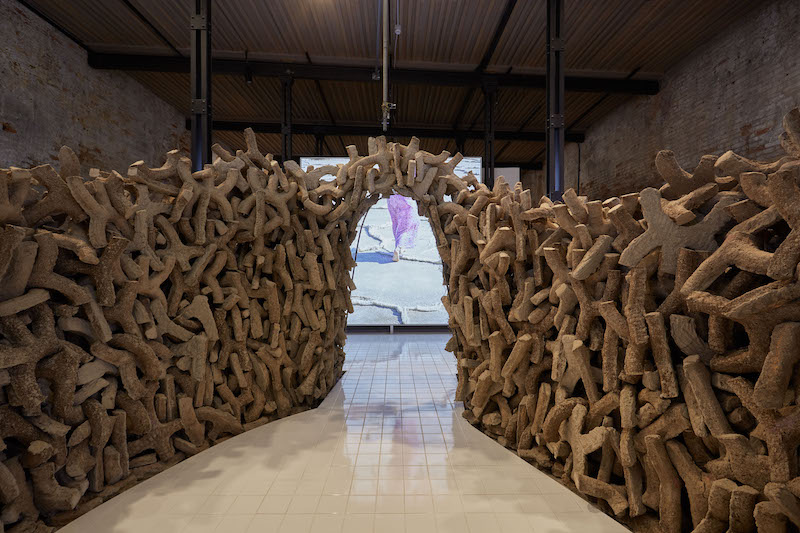The UAE Pavilion wins Golden Lion for best national pavilion at Venice Biennale 2021 Jun Sato’s laboratory and Yusuke Obuchi’s laboratory collaborated to support the UAE’s commissioners and ambitions

The Venice Biennale Architecture Exhibition is one of the most respected architecture exhibitions in the world. With a request from Kenichi Teramoto and Wael Al Awar, curators of the UAE (United Arab Emirates) National Pavilion, Jun Sato’s laboratory and Yusuke Obuchi’s laboratory collaborated to support the UAE’s commissioners and ambitions.
The UAE produces a large amount of salt as a byproduct during the desalination process of seawater. The main concept of the pavilion was to utilize magnesium, which was extracted from the salt, as a hardening agent for building parts made of cement.
| Golden Lion for Best National Participation |
| United Arab Emirates Wetland |
| Commissioner: Salama Bint Hamdan Al Nahyan Foundation Supporter: UAE Ministry of Culture and Youth Curators: Wael Al Awar and Kenichi Teramoto Venue: Arsenale Exhibitors Urban Researchers: Ahmed & Rashid Bin Shabib Researchers Wetland Research Team New York University, Abu Dhabi, Amber Lab University of Tokyo, Sato Lab and Obuchi Lab American University of Sharjah, Department of Biology, Chemistry and Environmental Sciences |


Comment from Jun Sato and Yusuke Obuchi
Sato-Lab proposed a simple solution for the production of 2500 pieces of the cement parts within a tight time constraint: make shallow trenches in the ground as a formwork and pour cement to be cured. This production process resulted in the making of "coral-shaped" pieces. We also proposed a structural design by synchronizing with Obuchi-sensei’s digital fabrication guiding system for sequential structural optimization to develop an assembly logic.Obuchi-Lab has designed and developed a human-centric digital fabrication system which supported assembly crew members on site by connecting them with real-time spatial and geometrical information of the 2500 pieces to be installed in a designated area. When pieces were installed in a shape of a ring and formed a layer, the collected spatial data of installed pieces was then analyzed for structural stability and overall geometrical accuracy. In the end of the fabrication process, we were able to create an architectural form as a result of integrating technology and nature, and craftsmanship and machine.
It is a great honor to be part of the work that received the Golden Lion, the highest award given, at this prestigious exhibition.
Joint statement by Jun Sato and Yusuke Obuchi
Message from Kazuyo Sejima, Chair of the International Jury for the Biennale Architecture 2021
At this Venice Biennale, there were many exhibited works that dealt with issues beyond the convention of architecture more than ever and hinted at new possibilities. I was particularly surprised to see many works that applied cutting-edge technologies. Also, in both the National and International pavilions, there were many exhibitions organized by teams of participants from various countries across national borders. The UAE Pavilion’s team was also made up of collaborators from multiple countries such as countries in the Middle East, Japan, and the United States. I was very pleased that the two laboratories of the University of Tokyo provided technical cooperation for the work. I hope that research activities in Japan will expand more and reach out overseas and play an active role.
Congratulations to Dr. Obuchi and Dr. Sato for their wonderful work and the Golden Lion Award.Kazuyo Sejima, Architect
Chair of the International Jury for the Biennale Architecture 2021
Data Sheet
The University of Tokyo Staff
Yusuke Obuchi, Associate Professor, Department of Architecture
Jun Sato, Associate Professor, Department of Socio-Cultural Environmental Studies
Mika Araki, Associate Professor, Kwansei Gakuin University School of Architecture
Shuta Takagi, Obuchi Lab Support Specialist
Yusuke Komata, Obuchi Lab Support Specialist
Kosuke Suehiro, Engineer, Jun Sato Structural Engineers Co., Ltd.
Obuchi Lab – student assistant credit list
Construction System & Network Development: Alex Orsholits
Scanning & Guiding Hardware Design: Zhou Li
System Documentation: Annette Choy de Leon
Scanning System: Pyaezone Aungsoe, Meredith Campbell Argenzio, Boon Hau Lim, Surjyatapa Raychoudhury
Guidance System: Yiyuan Qian, Alex Orsholits
Sato Lab – student assistant credit list
Structural Optimization System Development: Ren Imai, Shimpei Kojima, Yusuke Shimoyamada
Manufacturing & Structural Assemblage Development: Hirotaka Ujioka, Kenta Isebo
Construction Test: Ryoma Kanazawa, Miho Wada, Kousuke Miyano






